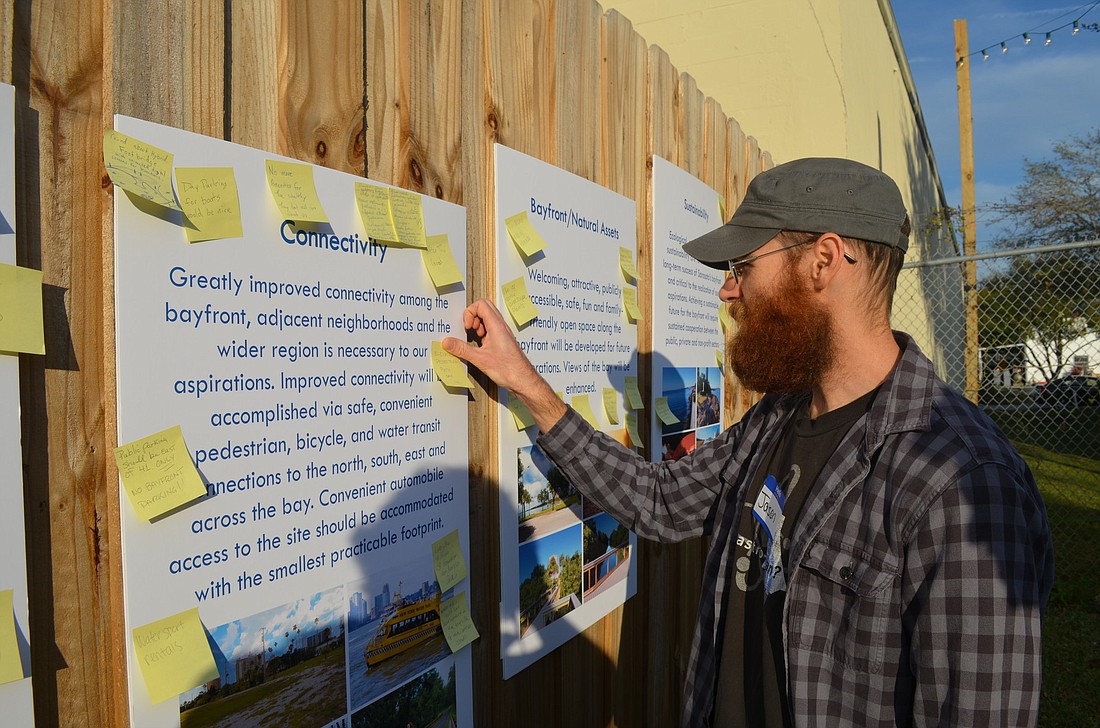- December 12, 2025
-
-
Loading

Loading

On Monday, City Commissioner Stan Zimmerman issued a challenge to Sarasota Bayfront 20:20.
The missive, given during a workshop updating the commission on Sarasota Bayfront 20:20’s work over the past six months, encouraged the group to aim high as it attempts to develop a community vision for a swath of city-owned bayfront land surrounding the Van Wezel Performing Arts Hall.
“When we built the Van Wezel, we knocked their socks off — nationally, and in some respects, internationally,” Zimmerman said. “I want to see the same kind of effort here, not just the same old stuff.”
For Bayfront 20:20 leadership, that imperative was a good sign. Not just because they agree that the finished project should be an iconic Sarasota destination, but because it feeds into the centerpiece of the group’s research and engagement.
Over the course of 70 meetings and six public workshops, Bayfront 20:20 has developed a series of six guiding principles, the heart of the organization’s work to date. With the assistance of New York-based community development consulting group HR&A Advisors, these principles have gone through a series of 17 drafts as Bayfront 20:20 has gathered hundreds of pages of input from the community.
The idea is that, as the conversation surrounding the development of the bayfront continues over the next several years, the principles will always serve as a touchstone for how to assess the options available for that land.
Although HR&A Vice Chairwoman Candace Damon said the principles are nearing completion, she also says there’s room for them to continue to evolve. Bayfront 20:20’s community engagement efforts are ongoing. On Saturday, an event at JDub’s Brewing Co. served as an opportunity for residents to offer more feedback and shape the principles even at this stage of the process.
“I think (residents) can influence the principles a lot,” Damon said. “The principles are really coming from the people in Sarasota.”
PRINCIPLES AND COMMENTS
Below are the six principles, along with comments residents gave pertaining to each at Saturday’s Bayfront 20:20 event.
1. Aspiration
Making the bayfront an iconic, public destination focused on the city’s cultural institutions and natural environment.
“ ... a major waterfront access area for all to enjoy, even if they are not monied.”
2. Natural assets
Developing publicly accessible space and enhancing views of the bay.
“Grand canal meandering through site with native plantings and foot bridges.”
3. Connectivity
Enhancing the connectivity of the bayfront to adjacent neighborhoods and the entire region.
“Water taxi to/from St. Armands and Ken Thompson Park.”
“Public parking should be east of 41 only. No bayfront parking!!”
4. Cultural heritage
Strengthening the bayfront’s identity as a cultural and arts destination.
“Establish a focal point state-of-the-art performing arts center. The others will follow.”
“Foster street performance in an area combined with sunset viewing.”
5. Activation
Building amenities and creating activities that will support the active use of the bayfront throughout the day and year-round.
“Create a permanent waterfront ‘wharf’ marketplace with housing of all price ranges.”
“Live music venue (public use).”
6. Sustainability
Ensuring development is both ecologically and economically sustainable.
“Low maintenance, low cost, maximum preservation of the shoreline and views for everyone.”
Quay in Play
Monday’s workshop also offered a glimpse at the thought process of GreenPointe Holdings, the Jacksonville developer that purchased the former Quay site for $27 million last month.
Based on meetings both city staff and Bayfront 20:20 leaders had with GreenPointe, there was a sense of optimism that some synergy could exist with the development of the 15-acre Quay site and the 42 acres of adjacent city-owned bayfront land.
“They’re very open to working with a cultural institution or cultural attraction if there’s a feasible partner that could be identified,” City Manager Tom Barwin said.
Klauber said GreenPointe representatives said they wanted the property to serve as a connecting point to downtown, and he felt positive about the developer’s interest in working with the Bayfront 20:20 planning process. As the push to develop the public land begins to solidify, Klauber said he believes surrounding private developments will start to align with those efforts.
“Once these things start to look real to people, I think we’re going to see a big change in the atmosphere out there,” Klauber said.
Next steps
Michael Klauber, leader of Bayfront 20:20, hopes to appear before the commission again in February to seek formal adaptation of the guiding principles from the city. In the ensuing four to six months, Klauber said he anticipated a three-pronged approach to move toward implementing those principles:
• Bayfront 20:20 will continue its community outreach and research best practices other communities have used to complete similar projects.
• Cultural institutions — particularly the Van Wezel and the Sarasota Orchestra — will evaluate their needs for the future to assist with the planning process.
• City staff will examine technical conditions surrounding the site, such as zoning and environmental issues.